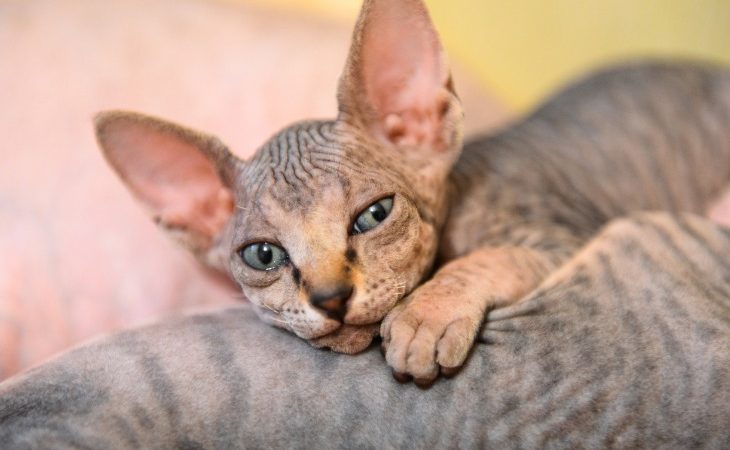In this article, we will list the top four hairless cat breeds. These cats are very loyal companions who generally do not tolerate loneliness well. Their skin has adapted to this lack of hair, but they nevertheless remain sensitive to the heat, the sun and the cold.
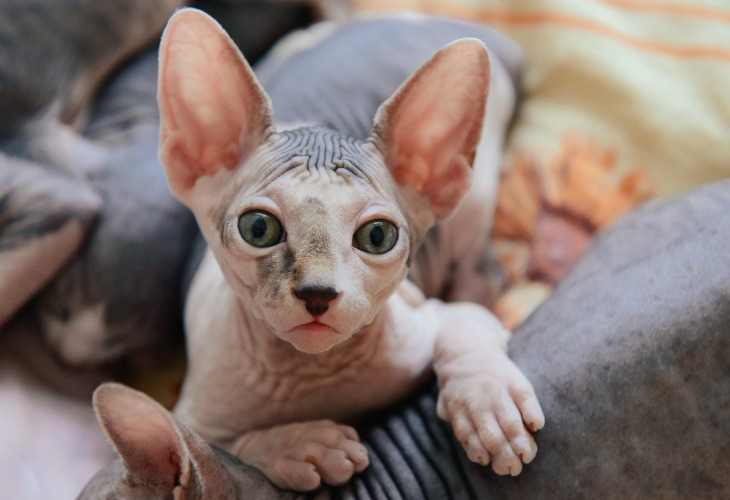
The Sphynx, the most famous hairless cat
The origins of the Sphynx
Originally from Canada and standardized in France, it is probably the star of hairless cats. This cat had a natural genetic mutation that was favored by breeders who wanted to create a new cat breed. The first litter of hairless cats was born in 1936, but some texts mention the existence of hairless cats who existed in the past.
Surprising physical characteristics
The Sphynx surprises people with its unique physical characteristics. Its lack of hair is not the only characteristic that differentiates it from other cats. For example, the shape of its skull is quite different because it longer and triangular in shape. The ears of this breed are large and its eyes are expressive and lemon-shaped. When it comes to their legs, they are long and very thin.
Because of its lack of hair, the skin of the Sphynx has become thicker than that of other cats. The skin can also be of several colors.
Contrary to popular belief, the Sphynx is not completely hairless. Its skin is covered with a fine down that is very soft to the touch and very pleasant to caress.
Personality and grooming
The loyalty of the Sphynx is legendary! It is extremely attached to its family! In addition, this cat likes to climb on its owner’s shoulders.
It’s important to remember that this cat needs to be protected from the cold. If you think that this cat’s lack of hair means that you can skip regular grooming sessions, this is totally false. The Sphynx’s skin must be moisturized regularly. You can use a special cat cream without perfume to hydrate your cat’s skin. A weekly bath is also recommended because this cat sweats. For this reason, it’s best to get this breed accustomed to regular baths from a very young age. Lastly, remember to keep an eye on and take care of its ears.
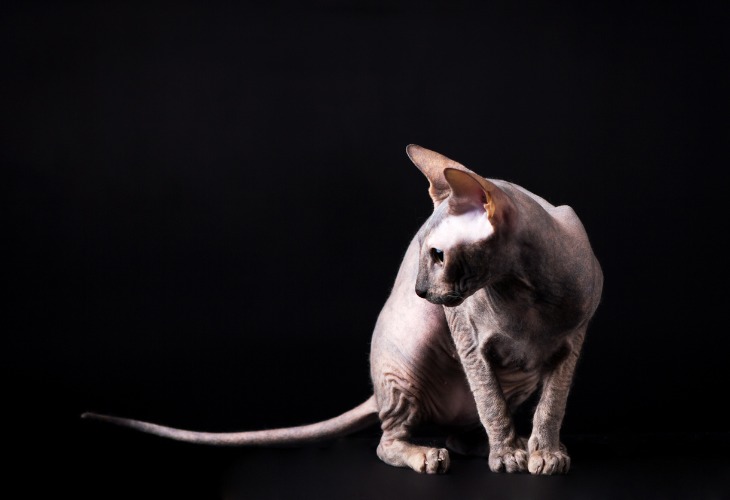
The Donskoy, a hairless cat from Russia
The genetic origins of the Donsloy
Native to Rostov-on-Don in Russia, the Donskoy is also called Don Sphynx and Russian Hairless. In 1987, a teacher named Elena Kovalena found a female kitten in the city of Rostov-on-Don. As the months passed the kitten started to lose all her hair. As an adult, she gave birth to a litter of kittens. Some of them were hairless like her, while others were born with hair. To Elena’s surprise, the cats that were born with hair started to lose it as they grew older like their mother did. A gene is responsible for this loss of hair and it appears quite quickly, more dominant compared to the other genes.
Types and physics
The Donskoy is a medium-sized cat with a muscular body and a fine and elegant look. Its bare skin is wrinkled, especially around the belly, neck and armpits. Like the Sphynx, its skin can be of any color.
There are four types of Donskoy cats:
- “Velour”: its skin is covered with a very short down,
- “Brush”: it has a very short and curly hair,
- “Flocked”: its skin appears bald and it is soft,
- “Rubber bald”: its skin is hairless and elastic.
Personality, grooming, and health
This cat breed is curious and intelligent. Its likes to explore its environment, while still being close to its owner. This cat cannot stand being alone and can sometimes be quite clingy, always asking for attention and cuddles.
This cat is very active—sometimes even considered hyperactive. It is not aggressive and does not try to defend itself when attacked. Because of this, it is best to refrain from keeping your cat unattended with other animals.
The absence of a dense coat on its body forces it to compensate. This means that this cat eats a lot. A rich and complete diet must be provided to this cat.
The Donskoy is a cat with robust health whose average lifespan can reach up to 19 years. With that being said, this cat is sensitive to lung infections.
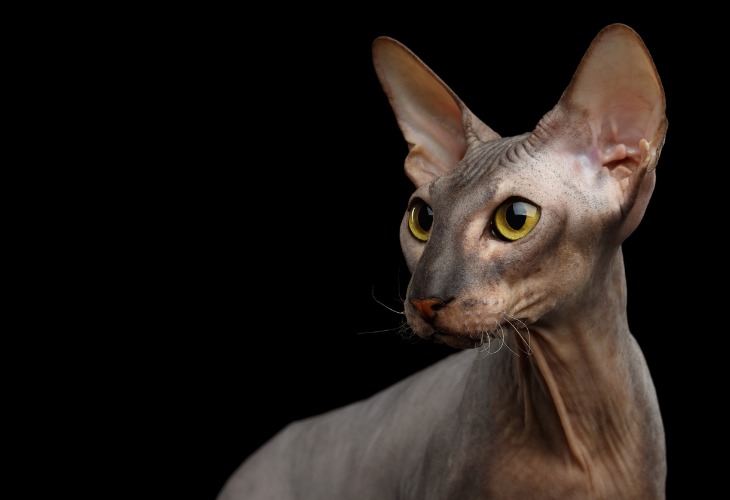
The Peterbald, the hairless cat of St. Petersburg
A cross between Oriental and Donskoy
This cat breed is quite new. Originally, the Peterbald was the result of a cross between an Oriental cat and a Donskoy. This cross was made for the first time in 1994 by Olga S. Mironova who mated a short-haired Oriental female with a hairless Donskoy cat in the city of Saint Petersburg in Russia. The kittens from this litter were the first Peterbalds. As time went on, crosses between Donskoy and Oriental became prohibited, then authorized again. The Siamese started to replace the Oriental cat when making crosses. Nowadays and according to the breed standard, the authorized crosses are Peterbald/Siamese, Peterbald/Oriental and two Peterbalds.
Physical characteristics and varieties
When it comes to the Peterbald’s physical characteristics, it has the slender and muscular silhouette of the Oriental cat and the skin of the Donskoy. Its head is long and triangular and its almond-shaped eyes are either blue or green. This breed does not have a pinch at the level of the nose which differentiates him from other hairless cat breeds.
Similar to the Donskoy, there are several varieties of the Peterbald. Here are just a few of them:
- completely hairless cats,
- the “flock” which have very short hairs that you hardly feel when you touch their skin,
- brushes which have velvet-like hairs,
- the “velvets” which have a bit of down.
The particularity of the Peterbald is that its coat evolves during its life. A kitten can be born with hair and lose it later and vice versa. Others will keep their coat for life. Regarding the color of her coat, it can be colorpoint, tabby, tortie, two-tone, smoke or plain.
An energetic cat
Extremely active, this cat is not suitable for anyone looking for a calm and composed cat. This cat inherited its personality from the Oriental cat and the Siamese cat. This breed prefers to live in a community and enjoys the company of other cats and animals because of its peaceful nature. The Peterbald does not like loneliness and can be very affectionate, even clingy with its owners. This cat is not an outdoor cat because it cannot stand the cold or the sun. Its skin is too sensitive. Do not hesitate to arrange your house so that your Peterbald has enough room to run around.
In summer, the Peterbald can sweat excessively. During this period, it’s best to give it a weekly bath with a suitable shampoo to get rid of excess sebum.
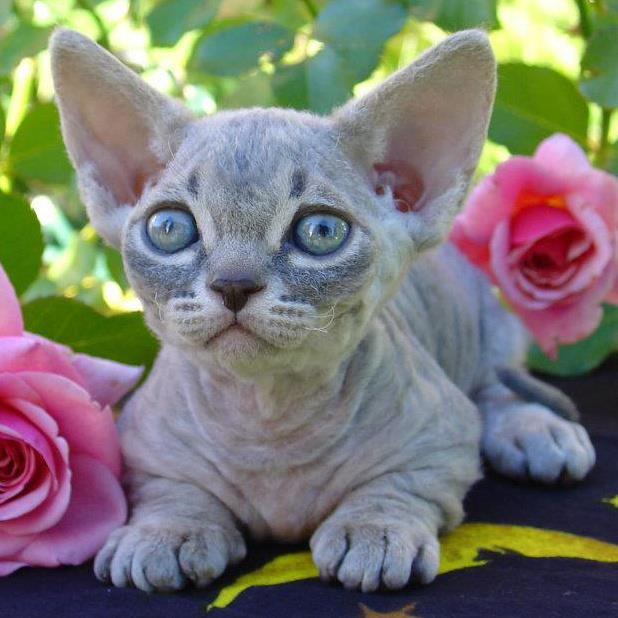
The Minskin, the smallest hairless cat
A rare cat breed
The Minskin is a particularly rare cat breed. Originally from the United States, specifically from Boston, it is a very new breed from 1998. It came to be from a cross between a Sphynx and a Munchkin cat. This is why this cat breed is a short-legged hairless cat. Paul McSorley wanted a cat whose coat color would be similar to the Siamese, but who would also be short-legged, much like the Corgi in dogs. He then decided to launch a breeding program where he made crosses between Munchkin, Sphynx, Birman and Devon Rex cats. He ended up getting the Minskin which is not yet recognized everywhere. Only the TICA (The International Cat Association) follows the development of the breed.
Three different varieties
Like the Peterbald and Donskoy, there are different varieties of Minskin:
- the completely hairless Minskin,
- Minskins with a fairly short coat,
- “fur-points”: a generally hairless body that has touches of hair on certain parts of the body such as his legs, his ears, his tail, or the face.
Its coat can display many colors but it is generally pink.
The Minskin has a long tail and short legs. It has large, round, expressive eyes.
A friendly and sensitive cat
When it comes to this cat’s personality, it likes to be cuddled by its owner. It will never get tired of being petted. In addition, this cat is extremely sociable. It gets along with animals just as well as it does with humans. The Minskin is a very intelligent cat that enjoys playing with its owner.
Regarding its health, this cat must be protected against bad weather—especially rain, cold and sun. A bath every two weeks is recommended for his skin. Concerning its diet, it should be high in protein so that its body temperature can handle cold and heat better.
These hairless cats are also perfect for people with allergies, as they produce very small amounts of Fel d1 protein, which is responsible for allergic reactions. These cats are the perfect little four-legged friends.

